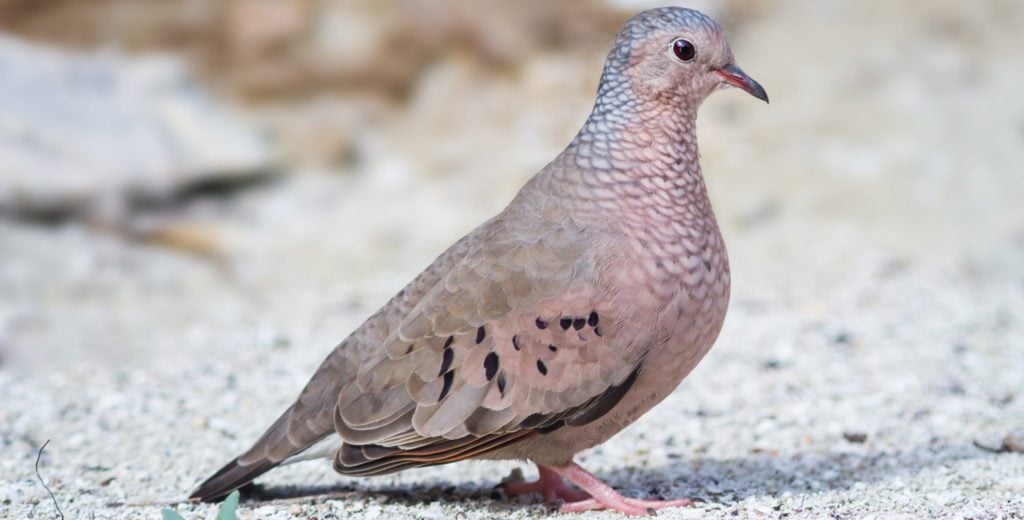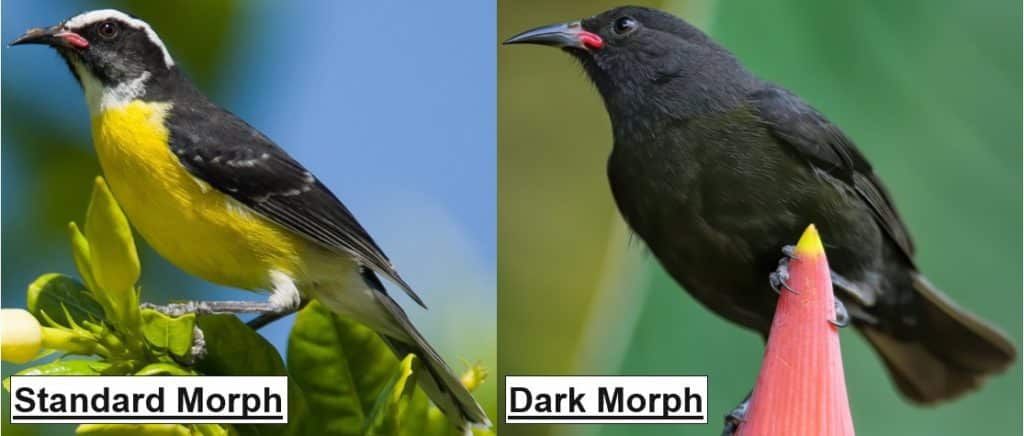11 Types of BIRDS Found on Curaçao! (COMMON)
Below you will find 11 COMMON BIRDS that live in Curaçao!

Believe it or not, over 210 species have been observed here, including many birds that only visit during migration. Because of the incredible variety, it would be impossible to list EVERY single type below.
So I did my best to come up with a list of the birds that are seen the MOST. Enjoy! 🙂
11 Common Birds of Curaçao:
#1. Green Heron
- Butorides virescens

Identifying Characteristics:
- Small heron with a long, dagger-like bill.
- Their back is gray-green. Head and neck are chestnut-brown, except for the green-black cap on the head.
- The neck is commonly drawn into their body.
This small heron is found in Curaçao in any wet habitat that includes lots of vegetation, which provides places for them to stay hidden. You will most often see them foraging at dawn or dusk, as they prefer to stay out of sight during most of the day.

Green Herons are ambush predators and mainly eat fish, waiting patiently for a small one to swim by so they can snap it up with their long bill. Interestingly, these birds actually use tools to help them hunt! They will drop insects, feathers, or other items into the water, which entice small fish to come closer to investigate.
The first time I heard the “skeow” call of an alarmed Green Heron, I had no idea what I heard because it was so unique. But luckily, these sounds are easy to learn, and now I can easily identify these herons when I’m visiting most wetlands.
#2. Caribbean Flamingo
- Phoenicopterus ruber

Also known as the American Flamingo.
Identifying Characteristics:
- Reddish-pink plumage.
- They measure from 120 to 145 cm (47 to 57 in) tall.
- The bill is white and pink with a large black tip.
These large birds are unmistakable in Curaçao!
The best places to find Caribbean Flamingoes are in shallow, saline lagoons. Like all flamingoes, they have a specialized beak, which is hooked downward, perfect for finding and filtering food in these habitats. Some common food items include small crustaceans, mollusks, some worms, nematodes, insects and their larvae, small fish, etc.
Despite their beauty, Caribbean Flamingoes sound just like geese! Listen below:
#3. Common Ground Dove
- Columbina passerina

Identifying Characteristics:
- These doves are small, being only slightly larger than a sparrow!
- They have a plain grey-brown back. The underparts have a pinkish tint to them.
- Small heads with a scaled pattern on their breast and neck. Dark spots on the wings.
Common Ground Doves are typically easy to find in Curaçao. Look for them feeding on the ground beneath bird feeders, cleaning up the grains and other seeds that fall from above.
These doves primarily nest on the ground! Simple nests are built lined with a few types of grass, weeds, and other plant matter. Being on the ground, they can make an easy meal for many predators. Their primary defense is to blend into their surroundings and thick vegetation.
Common Ground Doves are relatively vocal. They can be heard at all times of the day and at any time of the year. Listen for a repeated, soft, high-pitched coo with a rising inflection.
#4. Brown Pelican
- Pelecanus occidentalis

Identifying Characteristics:
- Brown skin on their giant throat patch.
- Dark gray bodies with a white neck and pale yellow head.
- Measures 3.5 – 5 feet in length (1 to 1.5 m) with a wingspan of 6.5 – 7.5 feet (2 to 2.3 m). The weight of adults can range from 4.4 to 11.0 lb (2 to 5 kg).
If you see a pelican in Curaçao while sitting on a beach, it is most likely a Brown Pelican. These large birds live strictly in saltwater habitats near the ocean’s coastline. Interestingly, they rarely venture into the open ocean, staying within 20 miles of the shore.
It’s a lot of fun watching Brown Pelicans hunting for fish! First, they fly high into the sky and then plunge aggressively headfirst into the water. These dives are meant to stun the surrounding fish, which then are scooped up with their enormous throat pouch and swallowed whole.
Check out the below video to learn more about their insane dives!

And lastly, they birds live a long time. The oldest Brown Pelican on record was 43 years of age!
#5. American Kestrel
- Falco sparverius

The American Kestrel is the smallest bird of prey in Curaçao.
But don’t let the tiny stature fool you because this raptor is an accomplished hunter. One of their favorite strategies to catch prey is to hover in the breeze from a relatively low height, looking for insects, invertebrates, small rodents, and birds.
Their diverse diet is one reason they can occupy ecological niches from central Alaska down to the southernmost tip of South America. But life can be tough when you’re the smallest falcon since they are sometimes eaten as prey by larger raptors and big snakes!
#6. Bananaquit
- Coereba flaveola

Identifying Characteristics:
- Adults range from 10-13 cm (4-5 in) long.
- Most adults have dark gray upperparts, a black crown, and a yellow chest, belly, and rump.
Bananaquits have something in common with many humans I know – a sweet tooth! Also known as “sugar birds” in Curaçao, this species is attracted to nectar feeders and bowls of sugar. They even enter homes looking for sweet treats.
Bananaquits are small, colorful, and known for adapting easily to human habitats. They like fruit and nectar, so they spend a lot of time near humans near flower gardens or fruit trees.
This species’ reliance on humans doesn’t stop with their diet. They often build their nests on human-made objects, including lampposts and garden trellises. Look for a globe-shaped tangle of sticks and leaves between 5 and 30 feet (1.5 to 9 m) off the ground.
#7. Magnificent Frigatebird
- Fregata magnificens

Identifying Characteristics:
- Long, narrow wings with a deeply forked tail.
- Males have a red throat patch, which is easily seen during the breeding season.
- Females have a white breast patch.
As the name implies, seeing these seabirds soaring effortlessly in the sky is quite “magnificent.” Using their forked tails to steer, they barely have to flap to stay afloat in the sky.
Due to the fact that their feathers are not waterproof like other seabirds, Magnificent Frigatebirds rarely land in the water and spend almost their entire lives flying. For food, they commonly steal fish from other birds or harass them until they regurgitate their meal, which they grab in midair! Their pirating ways have earned frigatebirds the nickname the “man-o-war bird.”
With Magnificent Frigatebirds, the “early bird” does not get the worm! Most individuals don’t take flight until later in the afternoon when thermals and winds are at their greatest. 🙂
#8. Carib Grackle
- Quiscalus lugubris

Identifying Characteristics:
- Males are glossy black.
- Females are dark grayish-brown.
- Both sexes have yellow eyes and pointed bills.
Like other types of grackles, this species is bold and can become very tame. It’s common to see Carib Grackles near people hoping to secure leftover food, even stealing items left unattended! These birds are especially abundant in Curaçao in cities near the coast.
Carib Grackles are highly gregarious, and it’s rare to see just one of them. They do everything from foraging for food together to roosting at night in colonies.
#9. Tropical Mockingbird
- Mimus gilvus

Identifying Characteristics:
- Adults range from 23-25 cm (9-10 in) inches long.
- Their coloration is silvery-gray above and whitish below, with a long black tail.
- They have white stripes above their eye, long dark legs, and a slim, black beak with a slight downward curve.
Tropical Mockingbirds prefer open habitats in Curaçao and avoid dense forests and mangroves. This species typically forages on the ground or in low vegetation. However, they may also perch and fly to catch insects like swarming termites.
These vocal birds are susceptible to parasitism by the Shiny Cowbird. Cowbirds lay their eggs in the Tropical Mockingbird’s nest, who then raises the chicks as their own. But, they have developed a unique adaptation to help them survive. Because up to 80% of nests are parasitized during their first brood, Tropical Mockingbirds lay second and third broods that aren’t affected.
Despite the name mockingbird, this species rarely mimics other birds. However, they often sing through the night and have various songs and calls.

#10. Saffron Finch
- Sicalis flaveola

Identifying Characteristics:
- Adults are 13-15 cm (5-6 in) long.
- The males are bright yellow with an orange crown.
- Females are similar but duller and may even be brownish and streaky in southern populations.
- They have a black upper beak and a pale lower beak.
Look for Saffron Finches in dry, open lowlands, including towns, parks, and river valleys. They don’t mind human-altered habitats, so you’ll likely see them while out and about.
These brightly colored birds in Curaçao are easy to attract.
They often visit bird feeders and are particularly fond of oats, but they also eat other seeds and insects. However, during breeding, males will aggressively defend their territory, chasing away other birds. They may even be aggressive with their mates and juveniles. Unfortunately, due to their hostile behavior, they are also illegally used for bird fighting.
Saffron Finches make a series of single and double notes and occasionally a brief trill.
https://youtu.be/o1R_KOTzC5I
#11. Rufous-Collared Sparrow
- Zonotrichia capensis

Identifying Characteristics:
- Adults range from 13-15 cm (5-6 in) inches long.
- Their wings and back are predominantly brown, their stomach is drab gray to white, and they have a rufous collar.
- They have a grayish-brown streak on the crown of their head with black lines on either side.
Look for this bird in Curaçao in grasslands, urban areas, parks, and gardens. Rufous-collared Sparrows are well-adapted to human development and have a large, expanding range.
Because of their enormous range and varied subspecies, Rufous-collared Sparrows have a wide range of behaviors. For example, some subspecies migrate while others are year-round residents. The males of some subspecies help raise their young, while others move on and breed with another female. Their songs and calls also vary by region.
Despite these differences between subspecies, Rufous-collared Sparrows are similar in appearance, so it’s fairly easy to recognize them by sight.
Which of these birds have you seen before in Curaçao?
Leave a COMMENT below! 🙂

